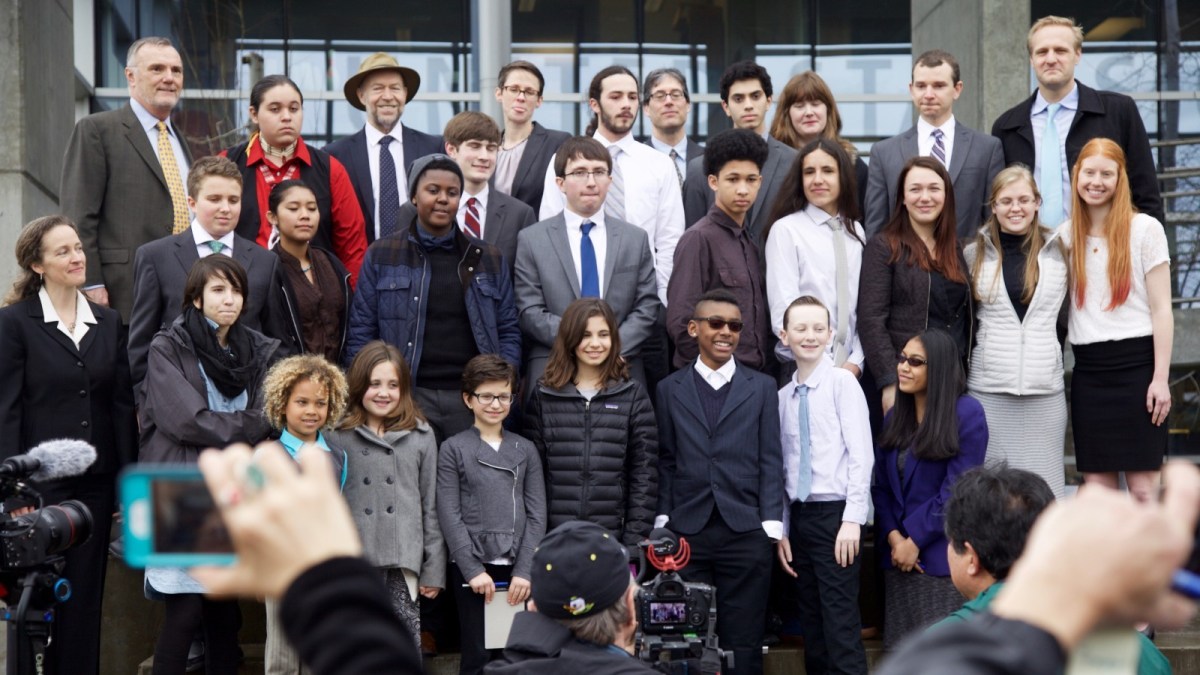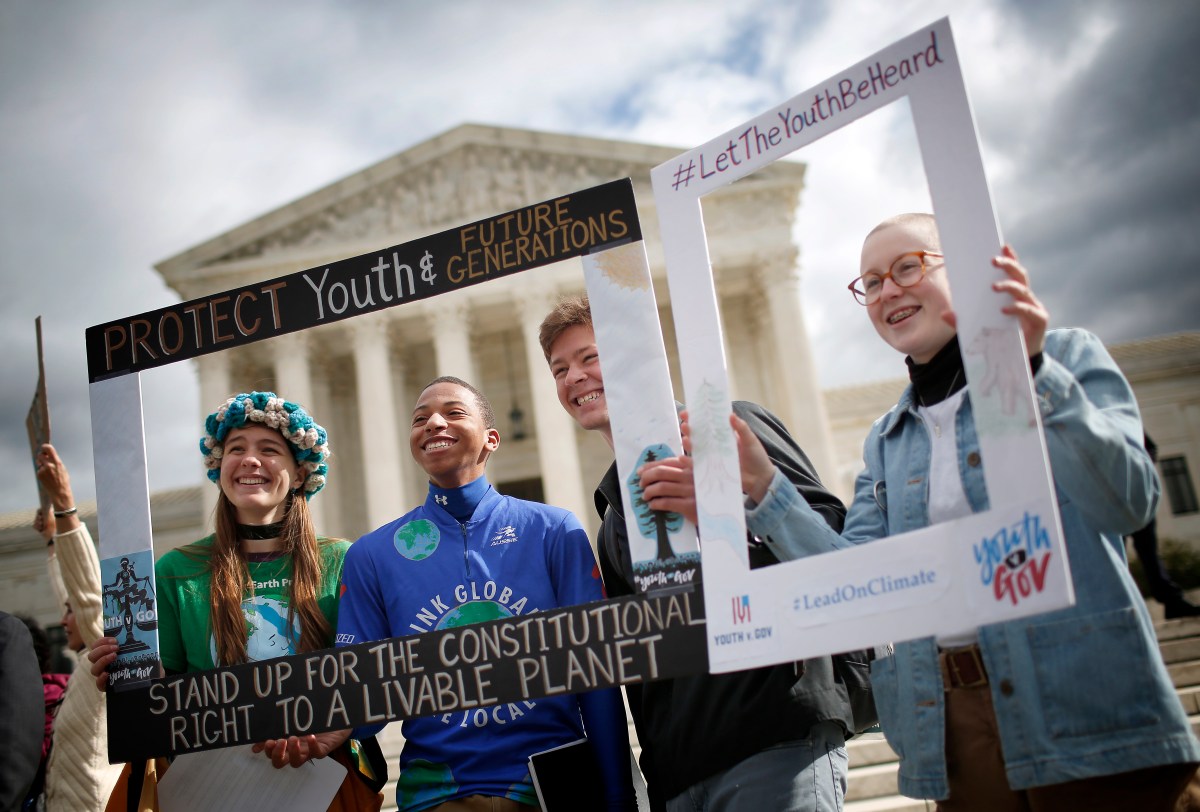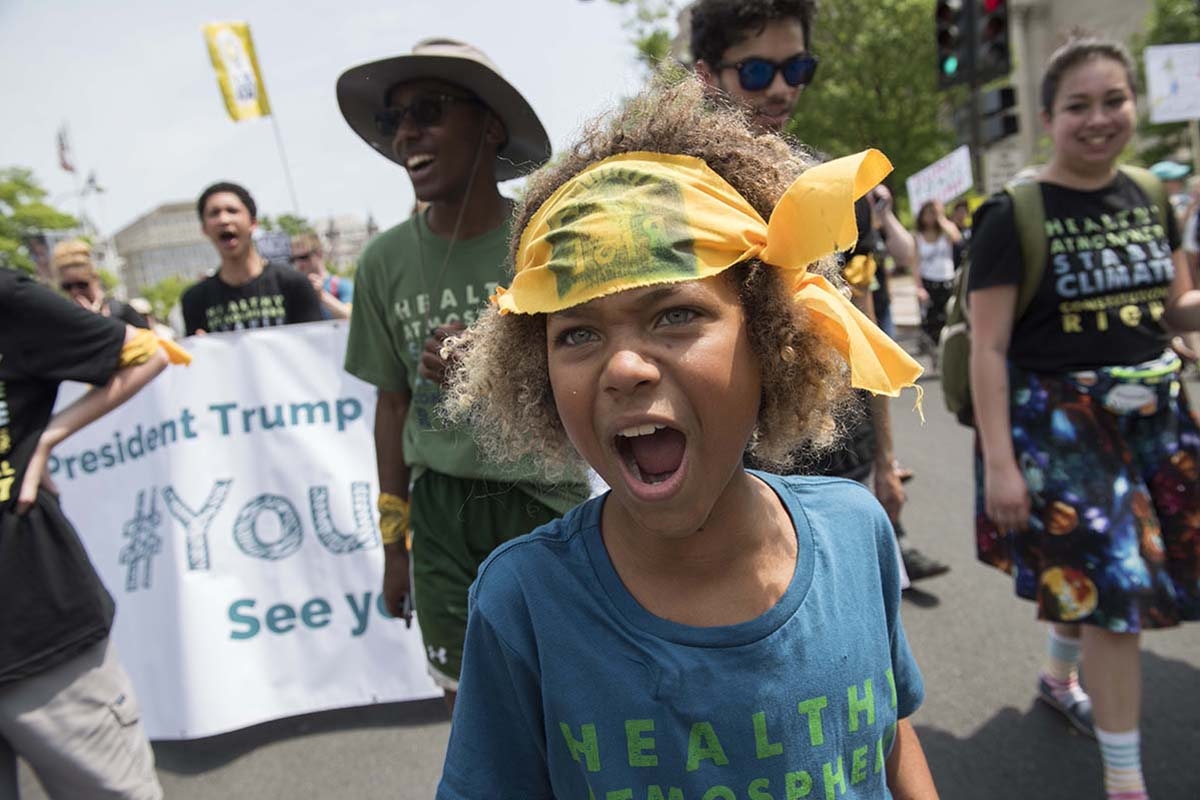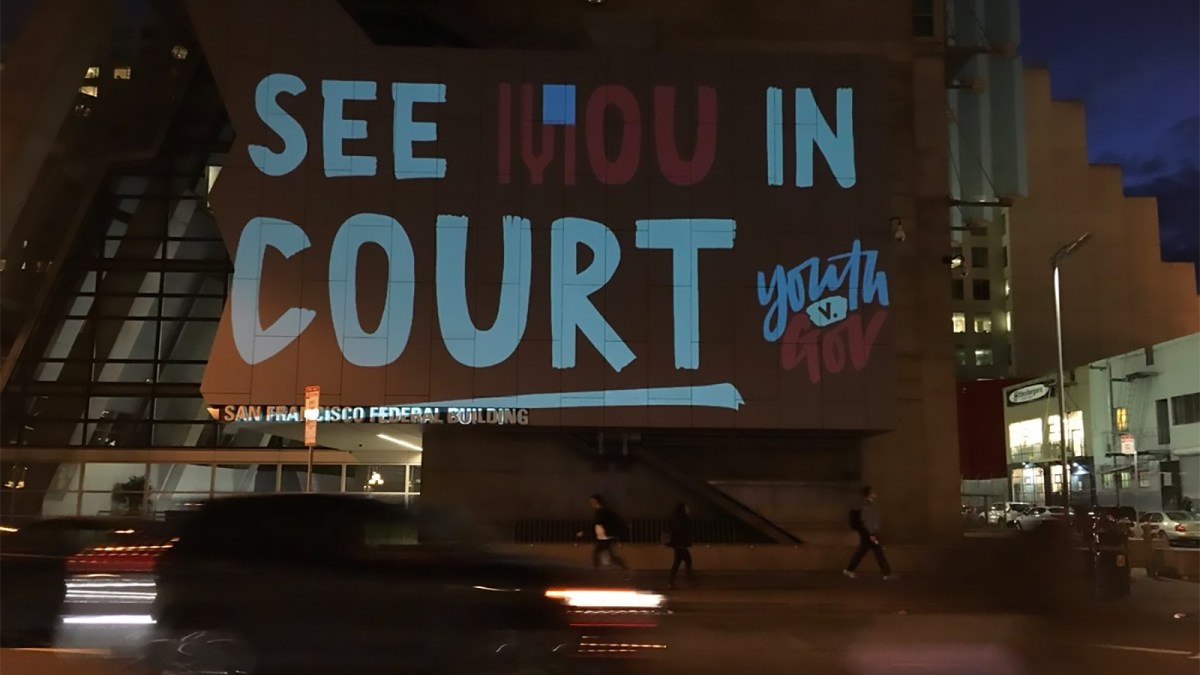Back in 2015, a pack of 21 kids sued the United States to try to force government action on climate change.
Four years later, that case — Juliana v. United States, or, affectionately, Youth v. Gov — is still tangled up in the courts. And the kids are losing their patience.
In a speech to a crowd of supporters after a June hearing in Portland, Oregon, Levi Draheim, the youngest of the plaintiffs at just 12 years old, made the argument as well as any grownup lawyer could.
“The constitution says that I have a right to life, liberty, and property,” Draheim said. “How am I supposed to enjoy life, liberty, and property, if one day, the island I live on will be underwater?”
A lifelong resident of a barrier island in Florida, Draheim has already had to evacuate his home during hurricane season, sandbagging the doors and bringing just his favorite books along with him. He’s experienced floodwaters up to his knees on days of heavy rain. And it’ll only get worse if we continue to sit on our hands.
The already-fraught court case brought by Draheim and his 20 co-plaintiffs has a long way to go before it sees a definite outcome (more on that later). But it’s worth asking: What’ll happen if the kids actually win?
WHAT THEY WANT
For the plaintiffs, the only adequate outcome is one that would return atmospheric carbon dioxide concentration to a cool 350 parts per million by the end of the century, limiting warming to 1 degree Celsius above pre-industrial levels. It’s a significantly more aggressive target than the 2-degree limit set by the Paris agreement, or even the 1.5-degree goal touted by the progressive Sunrise Movement. It’s particularly ambitious when you consider that we blew past 400 ppm in 2016.
But it’s a goal that recognizes that the U.S. is the biggest offender when it comes to climate pollution. It factors in the present impacts of climate change — like increased flooding and worsening wildfire seasons — and seeks not just to stop things from getting worse, but to reverse our current trajectory, getting us back to a climate system the likes of which these kids have never known.
“If humanity wishes to preserve a planet similar to that on which civilization developed and to which life on Earth is adapted … CO2 will need to be reduced … to at most 350 ppm,” famed Columbia University climate science professor James Hansen wrote in 2008. The same year, he said that such a goal was “still feasible … but just barely.”
Hansen’s granddaughter, Sophie Kivlehan, is one of the 21 youth plaintiffs — and Hansen is actually something of a symbolic plaintiff himself, called “Guardian for Future Generations.” It sounds like a Star Wars subplot, and even more so when you read this quote from his declaration to the court: “There is still time and opportunity to preserve a habitable climate system — if we pursue a rational course.”

The plaintiffs pose with climatologist James Hansen (top, third from left) and two attorneys. Clayton Aldern
HOW THEY’D DO IT
Us? Rational? Yeah, it’s a big dream — such a plan would require quick, massive changes to the U.S. energy system. But Our Children’s Trust, a nonprofit supporting the plaintiffs, wrangled together some climate pros from Evolved Energy Research (including expert witness Jim Williams, director of the Deep Decarbonization Pathways Project) to compile a report detailing how it could be done.
The 162-page report (which has not yet been peer-reviewed) basically comes down to “four pillars of decarbonization,” each of which will be crucial for meeting the ambitious 350 ppm goal: 1. “decarbonize” our electricity by replacing coal- and gas-fired power plants with solar panels and wind turbines, 2. do more with less by investing heavily in energy efficiency, 3. electrify our transportation infrastructure by replacing gas-powered cars, trucks, and buses with electric ones, and 4. — the kicker — suck carbon dioxide out of the air via a process called “carbon capture and storage.”
The report includes six potential pathways toward the goal — one base case, and five cases in which one crucial component of the base case becomes too expensive or can’t be deployed at scale (for example, if nuclear plants never become socially acceptable). Each case reaches net negative carbon emissions by about 2050. None of the cases assume that we’re going to change our wasteful ways (yes, you can still take those stupid-long showers), just that we’ll find ways to do what we do (like heat that shower water) more efficiently.
For the sake of not making this article 162 pages, we’ll just consider the base case.
One of the first priorities, according to the report, is to electrify the big stuff and get consumers off fossil fuels. As soon as possible in the early 2020s, heating and cooking equipment should be electrified in all new buildings (not unheard of — Berkeley just voted to ban natural gas in all new buildings), and as many new vehicles as possible should be electric as well. Super efficient heat pumps should replace air conditioners and heaters in existing buildings as quickly as possible. And we’ll need the infrastructure to support an increase in electric gadgets, which means more electric vehicle charging stations and updated power grids.
Now for those renewable energy resources. We’ll ultimately move toward a diverse portfolio, according to the report, including some additional nuclear facilities (though there’s a feasible case in which we don’t do that). But think of wind as Mr. Right Now: Most of the U.S. population has better access to wind than to solar, and wind is more dependable, so drastically increasing wind infrastructure is a top priority. Though there will always be plenty of solar in the mix, the plan’s big move that direction is set to happen around 2040, when there’ll be more demand for electricity thanks to all those electric vehicles and buildings, and when the cost of solar will presumably be a lot lower than it is now.
Evolved Energy Research sees a role for gas-fired power plants as a stopgap while we make the transition to renewable energy sources. But by the 2040s, synthetic fuels (produced by combining hydrogen with captured carbon) and biofuels will displace most liquid fuels and some amount of natural gas.
And then there’s carbon capture, or pulling CO2 out of the air. The easiest way to do this is to install catchers right at factories and power plants, where the stuff is puffing out of smokestacks. Under this plan, some of the captured carbon will be converted into synthetic gas, diesel, and jet fuel, some will be naturally stored in land sinks, and some will be injected into geological formations, where it will stay forever — (or so we hope: we’re not sure exactly how fast we can inject that carbon, or just how much we can scale up our land sink capacity over the long term).
How much might this cost, you ask? The report estimates that while the scenarios outlined in the report will increase U.S. energy spending from current levels (measured as a percentage of GDP), spending will still be pretty low compared to recent energy spending peaks. In 2009, the U.S. spent 9% of GDP on energy, while the Evolved Energy scenarios would put it at just 6 to 8%. And that’s not even taking into account all the money we’ll save in health costs and disaster relief, among other things.
The key to keeping it cheap: actually getting off those fossil fuels, so we can invest that money into new technology and infrastructure.
WHAT THE COURTS COULD DO
Basically, if the kids win this thing, we’ll be looking at a court order that the United States has to do its (uniquely enormous) part to stop climate change, meaning a totally revamped energy system.
To fulfill its hypothetical duties, the government would have to stop leasing public lands for coal mining and oil drilling — an action that the Ninth Circuit court could force any time now. Fossil fuel subsidies, which currently amount to billions of dollars every year, would probably be off the table, likely replaced by subsidies for clean energy sources like wind and solar, which would push a lot of private capital toward renewable energy technology, energy infrastructure, and mass transit, as well.
Pretty wild, right? But it’ll only happen if the courts rule completely in favor of the kids. And, the truth is, they could land any number of places. For example, a judge could agree that the youths’ rights have been violated, but decide that reducing warming to just 1 degree C isn’t possible or just isn’t necessary to make amends. In that case, it might “split the baby” and not require the full remedy that Our Children’s Trust seeks, says Andrea Rodgers, one of the lawyers representing the youth plaintiffs.
And interestingly, courts can get pretty particular about just how far defendants’ plans have to go. Take Brown v. Plata, a 2011 Supreme Court ruling about overcrowding in the California prison system. The court found that the prisoners’ 8th amendment rights — you know, that part about not being subjected to cruel and unusual punishment — were violated by the state’s jam-packed prisons, which were at 181% of their capacity at the time of the trial. But the court didn’t just rule that California prisons had to get back to capacity. In order to be in constitutional compliance, the court determined, California prisons had to reduce their population to 137.5% capacity. Oddly specific!
It’s not difficult to imagine the court ordering the government to develop a plan that would limit warming to 1.5 or 2 degrees C, rather than the requested 1 degree — a two-degree limit has long been the international standard, even if it would be a nightmare for much of the planet. Judges could even rule that the kids’ rights have been violated and still decide that the government doesn’t have to do anything at all.
Regardless of the details of the court ruling (this is all conjecture, after all) there’s another challenge: getting the government to actually follow through. Anyone who has watched police reform efforts around the country in the past few decades knows that it’s required some close, well, policing, from the courts. And even then, progress is halting if it’s happened at all.
Rodgers says the court could appoint a “special master” — an outside expert who can oversee the development of the plan. “Looking at the political situation, with our executive defendants demonstrating that they are incapable of understanding the gravity of the crisis, let alone how to solve it — we would seek the most stringent court supervision possible,” she says.
WHAT HAPPENS NEXT
But let’s back up for a minute here, because a whole lot has to happen before we get to a final decision.
Right now, we’re waiting for a decision from the Ninth Circuit Court of Appeals on whether the case can move forward to the district court, effectively restoring the case to where it was before the Trump administration’s latest appeal knocked it off course. That appeal was just one of the many roadblocks the case has faced since it began in 2015 — the first, an attempt by the Obama administration to toss it out completely. In the ensuing years, the case has bounced between the Oregon District Court, the Ninth Circuit Court of Appeals, and the Supreme Court, where the Trump administration has filed multiple motions and petitions to delay and stop it.
It’s looking pretty good for the kids right now — courts typically allow reasonable cases to go to trial, so parties can present their full slate of legal claims, according to University of Oregon environmental law professor Mary Wood. But it’s unclear when we’ll get that decision. It’s been over a month since the hearing in Portland, and there’s really no upper limit on how long it could take, although the court is likely to take the particular urgency of the case into account.
And at the same time it’s deciding whether the case can go to trial, the Ninth Circuit is also deciding whether to fulfill the plaintiffs’ request for a court order that would force the Trump administration to temporarily stop approving coal mining, offshore oil drilling, and new fossil fuel infrastructure on public lands. The purpose of the order, called a preliminary injunction, is “to keep the harm from severely worsening while the legal process is in play,” Wood says. (Basically, the clock’s a-tickin’!)
But that’s just the beginning. If the case does move to the district court, the Trump administration will almost certainly appeal again, Wood says, delaying the trial even further. If the district court rules in favor of the government, on the other hand, the kids will appeal. The losing side will likely push the case all the way to the Supreme Court if they can.
“It’s not a matter of if we’re getting to the Supreme Court, it’s a matter of when,” Rodgers says.
But OK, let’s say the case moves beyond the government’s labyrinth of appeals and actually gets a full hearing in the courts: For a court to order any remedy, split-baby or not, it first has to decide that the federal government violated the rights of the youth plaintiffs. To do that, the court could find that there is a constitutional right to a stable climate system, Rodgers says, or that the federal government has violated already-recognized rights, like the rights to life, liberty, and property — that stuff Levi Draheim was talking about.
If the government is found liable, the court will then make a decision, in a separate trial, about which remedy to order. The administration (Trump’s if he is still in the White house — or his successor’s) will then write up a plan to bring the government into constitutional compliance, and present it to the court. That will likely result in some back and forth, until the court agrees that the plan is sufficient.
It could take a while to get there, even though the Ninth Circuit court has already approved an expedited briefing schedule and fast-tracked the appeal. A preliminary injunction might help keep some fossil fuels in the ground — and send a message to energy companies that change is a comin’ — but if the government continues to fight and drag its feet, it could still be years before we see meaningful results.
As the plaintiffs know all too well, we don’t have that kind of time.

Protesters attend a rally outside the U.S. Supreme Court held by the group Our Children’s Trust. Win McNamee / Getty Images
LOOKING FORWARD
In Portland after the June hearing, Kelsey Juliana, 23, the oldest plaintiff and the one for whom the case is named, called Levi Draheim back up to the front of the stage and put her arm around him. With just about a decade between them, she said, they represent a crucial window of opportunity: The time it takes to get from Draheim’s age to Juliana’s is about as long we have, business-as-usual, before we seal our fate and lock in the temperature rise that scientists say will provoke unbearable heat, unprecedented disasters, and an ultimately uninhabitable planet.
In landmark school desegregation case Brown v. Board of Education, the Supreme Court ordered that schools had to desegregate “with all deliberate speed” — a phrase that, Wood says, would be right at home in the judges’ ruling in Juliana v. United States. But, as Thurgood Marshall realized in the aftermath of Brown, “deliberate” can be interpreted as “slow,” and litigation, in the face of insistent and creative opponents, often continues long after the trial wraps.
Could a decision made in the slow-moving court system and enacted by a plodding administration — even “with all deliberate speed” — ever be enough to tackle a problem as huge and as urgent as climate change?
“Right now, as we are in this last moment of opportunity, the Trump administration holds power over the lives of Americans that absolutely no administration ever has,” Wood says. “The bottom line is that the government has the tools to do this. It just needs to pull out the tools and get to work.”





